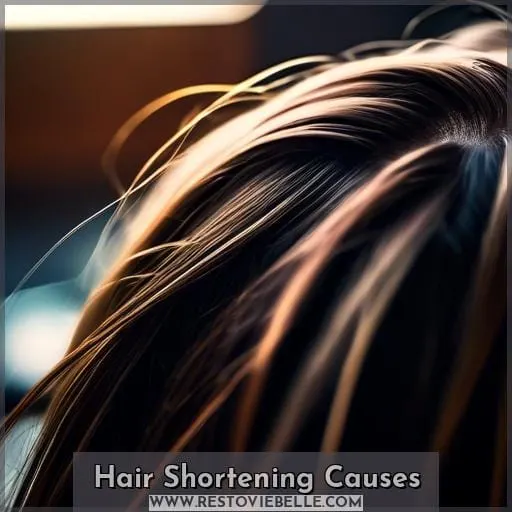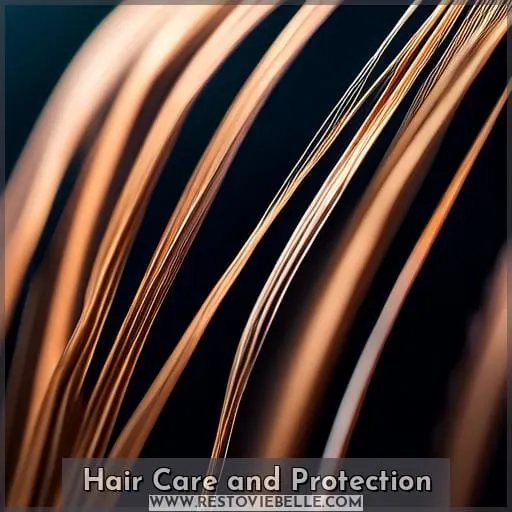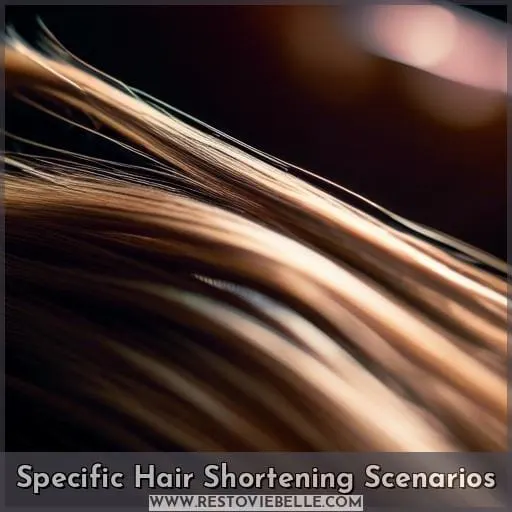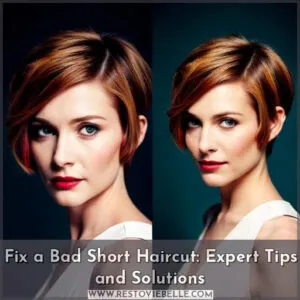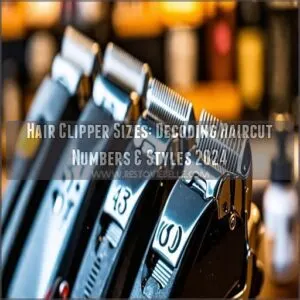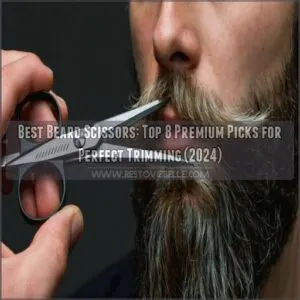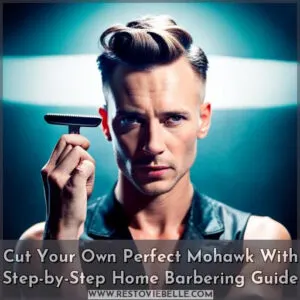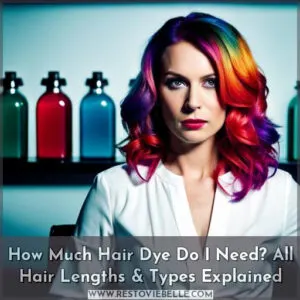This site is supported by our readers. We may earn a commission, at no cost to you, if you purchase through links.
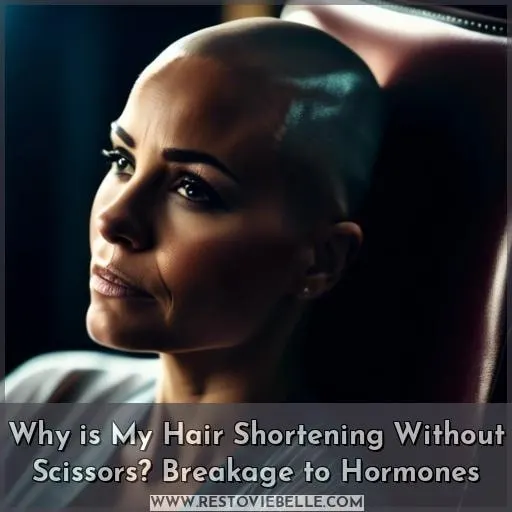 Despite your best efforts to grow your hair, you might find it’s mysteriously shortening. Don’t dismiss this as mere imagination; it’s a real issue that can stem from breakage, hormonal shifts, or stress.
Despite your best efforts to grow your hair, you might find it’s mysteriously shortening. Don’t dismiss this as mere imagination; it’s a real issue that can stem from breakage, hormonal shifts, or stress.
Understanding the underlying causes is crucial to regaining control and reversing the trend. Let’s delve into why your hair might be getting shorter without cutting it and explore strategies to nurture and protect your locks.
Yes, your hair may appear to be getting shorter without cutting it due to severe breakage, which causes hair to snap off, or because your hair growth cycle is shortening with age.
Table Of Contents
- Key Takeaways
- Hair Shortening Causes
- Hair Care and Protection
- Specific Hair Shortening Scenarios
- Preventative Measures
- Frequently Asked Questions (FAQs)
- Can certain hairstyles contribute to hair appearing shorter over time?
- How does the texture of a pillowcase affect hair length and health?
- Are there any specific nutritional deficiencies that can lead to hair shortening?
- Can hormonal changes during puberty also cause hair to appear shorter?
- Is it possible for hair to get shorter due to environmental factors such as pollution or climate?
- Conclusion
Key Takeaways
- Severe breakage due to chemical overprocessing or heat styling can cause hair to snap off, leading to the appearance of shorter hair without cutting it.
- Hormonal changes, such as those occurring during menopause or due to hypoparathyroidism treatment, can affect hair thickness, growth cycle, and texture, potentially leading to shorter hair.
- Stress and poor stress management can lead to conditions like telogen effluvium, where elevated cortisol levels disrupt hair growth cycles, causing hair thinning or loss, which may contribute to hair appearing shorter.
- Nutritional deficiencies, particularly in protein, can weaken hair, making it more susceptible to breakage and damage, which can result in hair appearing shorter over time.
Hair Shortening Causes
If you’ve noticed your hair seems to be getting shorter without a trip to the salon, you’re not alone. This phenomenon can be attributed to a mix of breakage, hormonal imbalances, stress, and underlying health issues.
Breakage often results from chemical treatments, heat styling, and rough handling, while hormonal changes due to conditions like hypothyroidism or menopause can alter hair growth patterns.
Stress can trigger conditions like telogen effluvium, leading to increased shedding. Addressing these factors with a balanced diet, gentle hair care, and consulting healthcare professionals for underlying conditions can help mitigate hair shortening.
Breakage and Damage
Your hair’s health can be compromised by various factors, leading to shortening and breakage.
- Chemical Overprocessing: Treatments like coloring, perming, or relaxing can weaken hair strands, making them prone to breakage.
- Heat Styling: Frequent use of heat tools such as blow-dryers, straighteners, and curling irons can strip moisture from your hair, causing it to become brittle and snap off.
- Aggressive Styling: Over-brushing or tight hairstyles can cause tension and stress on hair follicles, leading to breakage and potentially permanent hair loss known as traction alopecia.
- Nutritional Deficiencies: A diet lacking in essential proteins and vitamins can leave hair weak and susceptible to damage. Protein deficiency, in particular, can exacerbate hair loss and negatively affect hair growth.
To protect your hair, consider incorporating a balanced diet, reducing heat styling, and being gentle when handling your hair. Regular maintenance, such as trims, can also help prevent split ends and promote healthier hair growth.
If you’re experiencing significant hair breakage, it may be wise to consult a healthcare professional to identify any underlying health issues.
Hormonal and Health Issues
As we’ve seen, hair breakage and damage can lead to your hair getting shorter without the use of scissors. But let’s not overlook the impact of hormonal and health issues. Your body’s internal balance is a delicate dance, and when hormones or health are out of step, your hair can suffer.
- Menopause effects: The hormonal shifts during menopause can lead to thinner hair and a shorter growth cycle.
- Hypoparathyroidism treatment: Managing this condition is crucial as it can cause coarse, brittle hair and even hair loss.
- Eating disorder impact: Nutritional deficiencies from eating disorders can severely affect hair strength and length.
Stress Effects
Stress can have a profound impact on your hair health, potentially leading to hair shortening or loss.
- Emotional Impact: High stress levels can lead to a condition called telogen effluvium, where hair prematurely enters the resting phase and falls out.
- Cortisol Levels: Chronic stress elevates cortisol, a hormone that can disrupt hair growth cycles and lead to hair thinning or loss.
- Stress Management: Poor stress management can exacerbate hair issues, making it crucial to find effective ways to regulate mood and reduce stress.
To maintain hair health, it’s important to manage stress through lifestyle choices and stress management techniques. This can include regular exercise, meditation, and ensuring a balanced diet to support overall well-being and hair health.
Hair Care and Protection
To protect your hair from shortening without scissors, it’s essential to focus on a healthy diet, reduce heat styling, handle your hair gently, and maintain it regularly.
You can nourish your hair from the inside out by ensuring you consume enough protein and essential vitamins, which are crucial for hair strength and growth.
Minimizing the use of heat styling tools and always using a heat protectant can help prevent damage and breakage.
Additionally, being gentle when brushing and avoiding aggressive hair care practices will keep your hair’s integrity intact.
Regular maintenance, including trims every 6-8 weeks, can prevent split ends and promote healthier hair growth.
Healthy Diet
Continuing from the discussion on hair shortening causes, let’s delve into the role of a healthy diet in hair care and protection. Your hair’s health is significantly influenced by what you eat, making nutrient deficiencies a common culprit for hair getting shorter due to breakage and a disrupted hair growth cycle.
- Protein Intake: Ensure you’re getting enough protein, which is vital for hair growth and strength.
- Vitamin Consumption: Load up on essential vitamins, particularly those linked to hair health like vitamins A, C, D, and E.
- Regular Trims: While not directly related to diet, incorporating regular trims can help prevent split ends and promote healthier hair growth.
By addressing nutrient deficiencies and maintaining a balanced diet, you can help fortify your hair against breakage and support its growth.
Heat Styling Reduction
Following a healthy diet, the next step in preventing your hair from shortening is to reduce heat styling. Heat can severely damage your hair, leading to breakage and a shorter appearance.
-
Limit Heat Tool Usage: Use heat styling tools as sparingly as possible. When you do, always apply a heat protectant to create a barrier between the tool and your hair, minimizing damage.
-
Opt for Heatless Styling: Explore heatless methods to style your hair. Braids, twists, and buns can create beautiful styles without the need for heat, preserving your hair’s integrity and length.
-
Keep Tool Temperature Low: If you must use heat, set your styling tools to the lowest effective temperature. High heat settings can cause immediate and severe damage to your hair strands.
Incorporating these practices into your hair care routine can significantly reduce the risk of heat damage, helping to prevent your hair from getting shorter due to breakage.
Gentle Handling
Gentle handling of your hair is crucial for maintaining its length and health. Here are some tips to ensure you’re treating your hair with the care it deserves:
- Gentle Combing: Start at the ends and gently work your way up to avoid tangling and minimize breakage. Wide-toothed brushes are your best friend here, as they’re less likely to cause damage.
- Avoid Aggressive Brushing: Use a soft bristle brush and be gentle. Aggressive brushing can lead to hair breakage and loss.
- Brushing Technique: Brush your hair when it’s dry to reduce damage. If you must detangle when wet, use a wide-toothed comb and a detangling spray.
- Understand Your Hair: Recognize your hair texture, porosity, density, and patterns. This knowledge will guide you in choosing the right products and tools for your hair type.
By adopting these practices, you’re not just avoiding unnecessary shortening of your hair; you’re also promoting its overall health and vitality.
Regular Maintenance
Continuing from the importance of gentle handling to prevent hair damage, let’s delve into the significance of regular maintenance for hair care and protection. Your hair’s health isn’t just about what you avoid; it’s also about the proactive steps you take.
- Balance Protein and Moisture: Ensure your hair care routine includes the right mix of protein treatments and moisture-rich products to maintain hair strength and elasticity.
- Adjust Washing Frequency: Over-washing can strip hair of natural oils, leading to dryness and breakage. Tailor your washing schedule to your hair type and lifestyle.
- Nighttime Protection: Protect your hair from damage while you sleep by using a satin pillowcase or bonnet to reduce friction and moisture loss.
- Regular Trims: While it may seem counterintuitive, trimming your hair every 6-8 weeks helps prevent split ends and promotes healthier hair growth.
Specific Hair Shortening Scenarios
If you’ve noticed your hair seems to be getting shorter without the intervention of scissors, you’re not alone. This phenomenon can be attributed to a few key factors, including changes in your curl pattern and uneven hair lengths.
Such changes can make your hair appear shorter due to increased shrinkage or damage that leads to breakage. Understanding these specific scenarios is crucial in addressing the issue and promoting healthier hair growth.
Curl Pattern Changes
As you continue to care for your hair, it’s important to understand that your curl type and the overall health of your hair can change over time. These changes can be due to a variety of factors, including styling techniques, environmental exposure, and even genetic predisposition.
- Embrace your natural curl type and adjust your care routine as needed.
- Be mindful of texture alterations and treat your hair gently to maintain its integrity.
- Acknowledge density variations and choose products that cater to your hair’s current needs.
- Refine your styling techniques to minimize damage and promote hair health.
- Stay informed about genetic factors that may affect your hair and seek hair loss treatment tips if necessary.
By being proactive and adapting your hair care routine, you can help ensure your locks remain healthy, strong, and less prone to shortening without the need for scissors.
Uneven Hair Lengths
You might be puzzled by the uneven hair lengths across your scalp, especially if you haven’t cut your hair in a while.
-
Hair Damage and Breakage: Continuous stress on your hair from styles like ponytails or tight buns can lead to breakage, resulting in uneven lengths. Fine hair is particularly susceptible to this type of damage.
-
Natural Hair Cycle: Each strand of hair on your head is at a different stage of the natural hair cycle, which includes growth, rest, and shedding phases. Disruptions in this cycle can lead to uneven growth patterns.
-
Scalp Health: Maintaining a healthy scalp is crucial for even hair growth. Factors such as hormonal imbalances, nutritional deficiencies, or autoimmune conditions can affect scalp health and, consequently, hair growth.
To address these issues, consider implementing hair loss solutions tips, such as using gentle hair care products and avoiding styles that put excessive tension on your hair. Regular trims can help manage split ends and prevent further breakage. If you’re concerned about hair thinning or loss, consult a healthcare professional for hair loss remedies tips or hair loss cures tips tailored to your specific needs.
Remember, maintaining a balanced diet and protecting your hair from environmental damage are also key to promoting healthy, even hair growth.
Preventative Measures
If you’ve noticed your hair getting shorter without cutting it, you’re not alone. This phenomenon can be perplexing, especially if you’re aiming for longer locks.
To combat this issue, it’s crucial to understand the underlying causes and adopt preventative measures. Regular trims are essential for removing split ends and preventing further breakage, which can make hair appear shorter over time.
Protecting your hair at night, for instance, by using a satin pillowcase or bonnet, can reduce friction and breakage. Additionally, environmental factors like UV exposure and pollution can weaken hair, so incorporating protective and nourishing hair care products into your routine is beneficial.
By addressing these aspects, you can help ensure your hair remains healthy, strong, and capable of reaching your desired length.
Regular Trims
A Key to Preventing Hair Shortening
Regular trims might seem counterintuitive when you’re trying to grow your hair, but they’re essential for maintaining healthy length and preventing your hair from getting shorter without scissors. By addressing split ends and hair breakage, trims can actually help your hair grow longer and healthier over time.
- Prevent Split Ends: Regular trims remove split ends, which, if left untreated, can travel up the hair shaft and cause more significant breakage.
- Promote Hair Growth: Removing damaged ends encourages healthier hair growth, as your hair isn’t wasting resources on repairing broken strands.
- Maintain Moisture and Protein Balance: Trims help maintain a healthy balance between moisture and protein within your hair, preventing breakage due to brittleness or over-elasticity.
In essence, incorporating regular trims into your hair care routine is a proactive step towards not only preventing your hair from getting shorter due to damage but also ensuring it remains strong, healthy, and vibrant.
Night Protection
Continuing from the importance of regular trims, let’s delve into the significance of night protection for your hair. While you’re asleep, your hair is vulnerable to breakage due to friction against your pillowcase.
- Satin pillowcases: They reduce friction, helping to prevent hair breakage and maintain moisture levels.
- Protective bonnets: Wearing a bonnet can protect your hair from the roughness of cotton and help retain its natural oils.
- Sleeping habits: Adjusting how you sleep can minimize stress on your hair, reducing the risk of damage.
These measures, alongside managing hormonal imbalances, can help keep your hair’s integrity intact and prevent it from shortening.
Environmental Factors
Continuing from the importance of night protection for your hair, let’s delve into the environmental factors that can also play a significant role in preventing your hair from shortening.
- Shield from UV Exposure: Just as you protect your skin from the sun, your hair needs defense against UV rays. Wear a hat or use hair products with UV filters to minimize damage.
- Avoid Harsh Chemical Treatments: Chemical straighteners and dyes can weaken your hair. Opt for gentler, more natural styling techniques to maintain hair integrity.
- Reduce Pollution Contact: Pollution can be detrimental to your hair’s health. Cover your hair in high-pollution areas and ensure you wash it regularly to remove any accumulated toxins.
Frequently Asked Questions (FAQs)
Can certain hairstyles contribute to hair appearing shorter over time?
Yes, certain hairstyles can indeed make your hair appear shorter over time.
Tight styles like ponytails, braids, or cornrows pull on the hair and can lead to traction alopecia, causing hair loss and making hair seem shorter.
How does the texture of a pillowcase affect hair length and health?
The texture of your pillowcase can significantly impact your hair’s length and health.
Satin and silk pillowcases, known for their smooth surfaces, reduce friction and prevent hair breakage, helping maintain hair length and improve overall hair health.
Are there any specific nutritional deficiencies that can lead to hair shortening?
Yes, specific nutritional deficiencies can indeed lead to hair shortening.
Iron-deficiency anemia, for instance, disrupts the hair growth cycle due to the hair follicle’s requirement for iron.
Similarly, zinc deficiency affects hair tissue growth and repair, potentially leading to hair loss.
Vitamins such as Vitamin E, essential for healthy skin and hair, and Vitamin A, necessary in the right amounts for hair growth, are also crucial.
Deficiencies in Niacin (Vitamin B3), Vitamin B12, and essential fatty acids like Omega-3 and Omega-6, as well as amino acids L-lysine and L-methionine, can influence hair health, leading to brittleness, lifelessness, and ultimately hair loss.
Can hormonal changes during puberty also cause hair to appear shorter?
Yes, hormonal changes during puberty can indeed cause hair to appear shorter. They can affect hair texture and growth patterns, leading to changes in hair’s appearance and structure.
Is it possible for hair to get shorter due to environmental factors such as pollution or climate?
Yes, environmental factors like pollution and climate can indeed cause your hair to shorten.
Pollutants can settle on your scalp and hair, leading to damage, breakage, and a reduction in hair growth proteins.
Protecting your hair involves minimizing exposure and using products that shield against these environmental aggressors.
Conclusion
Just as a river shapes the landscape through which it flows, leaving its mark long after it recedes, the journey of your hair is shaped by various elements, from breakage and hormonal shifts to the stress of daily life.
Understanding why your hair is getting shorter without cutting it’s the first step towards navigating these waters. By embracing a holistic approach to hair care—incorporating a nutrient-rich diet, reducing heat styling, and handling your hair with care—you set the stage for stronger, healthier locks.

